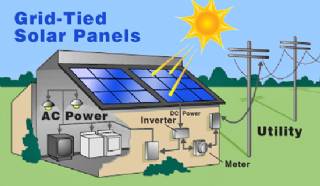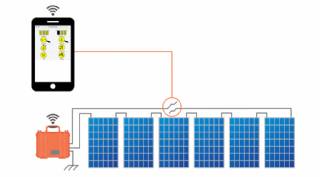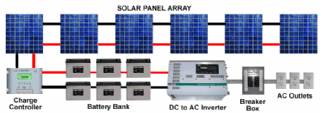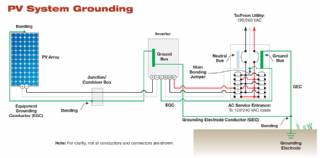Solar Energy Systems - Solar Inverter - Solar Panel Inverter

Inverters take care of four basic tasks of power conditioning:
• Converting the DC power coming from the PV modules or battery bank to AC power
• Ensuring that the frequency of the AC cycles is 60 cycles per second
• Reducing voltage fluctuations
• Ensuring that the shape of the AC wave is appropriate for the application, i.e. a pure sine wave for grid-connected systems
Criteria for Selecting a Grid-Connected Inverter – The following factors should be considered for a grid-connected inverter:
• A UL1741 listing of the inverter for use in a grid-interactive application
• The voltage of the incoming DC current from the solar array or battery bank.
• The DC power window of the PV array
• Characteristics indicating the quality of the inverter, such as high efficiency and good frequency and voltage regulation
• Additional inverter features such as meters, indicator lights, and integral safety disconnects
• Manufacturer warranty, which is typically 5-10 years
• Maximum Power Point Tracking (MPPT) capability, which maximizes power output
Most grid-connected inverters can be installed outdoors, while most off-grid inverters are not weatherproof. There are essentially two types of grid-interactive inverters: those designed for use with batteries and those designed for a system without batteries.
Power Quality – Inverters for grid-connected systems produce better than utility-quality power. For grid-connection, the inverter must have the words “Utility-Interactive” printed directly on the listing label.
Voltage Input – The inverter’s DC voltage input window must match the nominal voltage of the solar array, usually 235V to 600V for systems without batteries and 12, 24 or 48 volts for battery-based systems.
AC Power Output – Grid-connected systems are sized according to the power output of the PV array, rather than the load requirements of the building. This is because any power requirements above what a grid-connected PV system can provide is automatically drawn from the grid.
Surge Capacity – The starting surge of equipment such as motors is not a consideration in sizing grid-connected inverters. When starting, a motor may draw as much as seven times its rated wattage. For grid-connected systems, this start-up surge is automatically drawn from the grid.
Frequency and Voltage Regulation – Better quality inverters will produce near constant output voltage and frequency.
Efficiency – Modern inverters commonly used in residential and small commercial systems have peak efficiencies of 92 percent to 94 percent, as rated by their manufacturers. Actual field conditions usually result in overall efficiencies of about 88 percent to 92 percent. Inverters for battery-based systems have slightly lower efficiencies.
Integral Safety Disconnects – The AC disconnect in most inverter models may not meet requirements of the electric utility (see section “Disconnects”). Therefore, a separate exterior AC disconnect may be required even if one is included in the inverter. All inverters that are UL listed for grid-connection include both DC disconnects (PV input) and AC disconnects (inverter output). In better inverters, the inverter section can be removed separately from the DC and AC disconnects, facilitating repair.
Maximum Power Point Tracking (MPPT) – Modern non-battery based inverters include maximum power point tracking. MPPT automatically adjusts system voltage such that the PV array operates at its maximum power point. For battery-based systems, this feature has recently been incorporated into better charge controllers.
Inverter-Chargers – For battery-based systems, inverters are available with a factoryintegrated charge controller, referred to as inverter-chargers. Be sure to select an inverter-charger that is rated for grid-connection, however. In the event of a grid power outage, use of an inverter-charger that is not set up for grid-connection would result in overcharging and damaging the batteries, known as “cooking the batteries.”
Automatic Load Shedding – For battery-based systems, the inverter can automatically shed any unnecessary loads in the event of a utility power outage. Solar loads, i.e. the loads that will be kept powered up during the outage, are connected to a separate electrical sub-panel. A battery-based system must be designed to power these critical loads.
Warranty – Inverters typically carry warranties of 5 years, although the industry is moving toward a 10-year warranty. The transformer and solid state components of an inverter are both susceptible to overheating and damage from power spikes, reducing its life. Transformerless inverters, long available in Europe, are beginning to move into the U.S. market.
Labels
solarpowerpanelsolar energy (industry)inverterbattery bankenergyoff gridcharge controllerrenewablegreenhow tosolar panel (product category)grid-tie inverterinverterssolar system costsolar system pricewiringarray100w coleman12vdcsinewavecarmanahgreenpowersciencewind turbine (industry)power invertersolar system price in pakistangogreensolaralternatorturbinephotovoltaicsolar system cost in pakistanFarming Principle: Deep Soil Preparation
Looking at GB as a three-legged stool, deep soil preparation is one of the legs. Deep soil preparation builds soil and soil structure by loosening the soil to a depth of 24 inches (60 cm). Ideal soil structure has both pore space for air and water to move freely and soil particles that hold together nicely.

Smart Home Ecosystem - Smart Home Automation - Smart Home Security - Smart Home Technology
The outer-most level corresponds to the individual devices and sensors that consumers interact with. Several candidates are vying for the role of a leader introducing smart home services to the mass market.

Solar Energy Systems - Solar Modules - Solar Electric System Design - Solar Power
The heart of a photovoltaic system is the solar module. Many photovoltaic cells are wired together by the manufacturer to produce a solar module. When installed at a site, solar modules are wired together in series to form strings. Strings of modules are connected in parallel to form an array.
Solar Energy Systems - Array Mounting Racks - Solar Ray - Solar Panel - PV Racks and Mounts
Arrays are most commonly mounted on roofs or on steel poles set in concrete. In certain applications, they may be mounted at ground level or on building walls. Solar modules can also be mounted to serve as part or all of a shade structure such as a patio cover. On roof-mounted systems, the PV array is typically mounted on fixed racks, parallel to t

Solar Energy Systems - Grounding Equipment
Grounding equipment provides a well-defined, low-resistance path from your system to the ground to protect your system from current surges from lightning strikes or equipment malfunctions. Grounding also stabilizes voltages and provides a common reference point. The grounding harness is usually located on the roof.

Solar Energy Systems - Solar Disconnects
Automatic and manual safety disconnects protect the wiring and components from power surges and other equipment malfunctions. They also ensure the system can be safely shut down and system components can be removed for maintenance and repair.

Solar Energy Systems - Solar Battery Bank
Batteries store direct current electrical energy for later use. This energy storage comes at a cost, however, since batteries reduce the efficiency and output of the PV system, typically by about 10 percent for lead-acid batteries. Batteries also increase the complexity and cost of the system.

Solar Energy Systems - Solar Charge Controller
A charge controller, sometimes referred to as a photovoltaic controller or battery charger, is only necessary in systems with battery back-up. The primary function of a charge controller is to prevent overcharging of the batteries. Most also include a lowvoltage disconnect that prevents over-discharging batteries. In addition, charge controllers pr

Solar Energy Systems - The NEC and PV Systems
Solar PV systems must be installed in accordance with Article 690 of the National Electric Code, which specifically deals with PV systems, as well as several other articles of the NEC that pertain to electrical systems in general. When there is a conflict between NEC 690 and any other article, NEC 690 takes precedence due to the unique nature of PV

Ventilation Systems - Natural Ventilation
The bigger the both factors are the more intensive is the air change in rooms. This means that in colder weather conditions the rooms and the building is often over-ventilated and in warmer and windless weather, there is a lack of fresh air. As both of these factors are directly dependent on the external climate, the system is considered to be a no